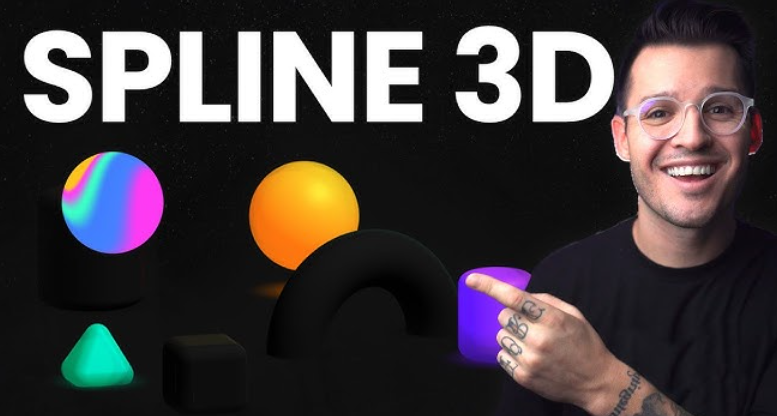
In today's rapidly evolving digital landscape, Spline 3D design has emerged as an indispensable skill no creative professional can afford to ignore. This powerful, browser-based 3D design tool is revolutionizing how we create immersive digital experiences.
Whether you're a seasoned graphic designer looking to expand your toolkit or a beginner eager to dive into the world of 3D modeling, understanding the nuances of Spline will provide invaluable insights and actionable strategies. This comprehensive guide will explore all aspects of your Spline 3D design journey, offering practical knowledge and proven approaches to help you achieve success in 2025 and beyond.
From Flat to Fab: Why 2025 is Your Year for Mastering Spline 3D Design
For many 2D designers, traditional 3D design software presents significant hurdles: a steep learning curve and often prohibitive costs. These factors have historically created a barrier to entry into the world of three-dimensional creation.
However, as we move into 2025, the demand for immersive and interactive web experiences is skyrocketing. This makes 3D design a critical skill for anyone looking to stand out online and capture audience attention.
This is where Spline truly revolutionizes the landscape. It offers a user-friendly, browser-based, no-code 3D design tool that empowers virtually anyone to create stunning 3D visuals. Spline effectively solves the pain point of complexity, allowing you to focus on creativity rather than wrestling with intricate software. Its intuitive platform enables designers to create interactive 3D elements directly within their web browser, making the transition from 2D to 3D remarkably accessible.
Your First Steps with Spline: Embracing the 3D Mindset in 2025
Transitioning from 2D design to 3D requires a fundamental shift in mindset. You'll begin to think about depth, shadows, and real-world physics. Fortunately, Spline makes this transition remarkably accessible and intuitive.
Your initial focus should be on getting familiar with Spline's streamlined interface. It's specifically designed to feel less intimidating than traditional 3D modeling software, allowing for a smoother learning curve.
Next, grasp the foundational elements that form the core of any Spline project:
- Objects: Your primary building blocks for any scene.
- Materials: Define how your objects look, including color, reflectivity, and texture.
- Lights: Crucial for how your 3D elements are seen and for creating mood.
- States: Allow for variations of an object's properties, essential for interactivity.
- Events: Define how objects react to user input or other triggers.
Engaging with your first Spline tutorial will be key to understanding basic navigation and tool functions. Don't hesitate to experiment with applying different Textures and observing how they interact with lighting to achieve realistic and visually appealing 3D visuals.
Building Your First Interactive Scenes: Spline's Core Tools in Action
Once you're comfortable with the basics, it's time to dive into Spline's intuitive modeling tools. Explore features like extrusion, beveling, and Boolean operations to transform basic shapes into sophisticated 3D models. This is where your creativity truly begins to take shape.
A core strength of Spline lies in its ability to create engaging interactive scenes. Learn to utilize ‘States' to define different appearances for your objects and ‘Events' (such as On Click, On Hover, or On Start) to trigger dynamic responses. This functionality allows you to build truly immersive user experiences.
To add motion and personality, start experimenting with simple 3D animations. Even subtle movements can make your interactive scenes truly pop and capture attention.
Practice is paramount in mastering any design tool. Follow dedicated Spline tutorials or challenge yourself by remixing existing community creations. This hands-on approach will help you understand diverse techniques and workflows. Remember, don't be afraid to experiment! Just like with Photoshop or other design software, becoming proficient in Spline comes from continuous practice and creative problem-solving.
Showcasing Your Spline Creations: Integration & Performance in 2025
Creating stunning 3D designs with Spline is only half the journey; showcasing them effectively is crucial. Understand Spline's various export options – including iframe, component, and image – to seamlessly integrate your 3D creations into any website or digital platform.
Performance optimization is key for web-based 3D. Learn best practices for optimizing your Spline creations, such as reducing polygon count and compressing textures. These steps are vital to ensure fast loading times and smooth performance, providing an excellent user experience.
Beyond web integration, transform your designs into impactful 3D mockups for client presentations or dynamic product showcase elements on e-commerce sites. This adds a professional and modern touch to your work.
In 2025, leverage platforms like VIVERSE to exhibit your interactive 3D works. A strong portfolio featuring your Spline projects will significantly help you stand out to potential employers or collaborators. Furthermore, consider how these projects can enhance your personal branding, adding a cutting-edge, tech-forward edge to your professional identity.
Elevating Your Spline Skills: Community, Resources, and Beyond in 2025
Your Spline 3D design journey is an ongoing process of learning and refinement. Continuously improve your skills by tapping into Spline's official tutorials, exploring its extensive template library, and engaging with the vibrant Discord community. These resources are invaluable for growth.
You'll inevitably encounter common challenges, such as your ‘3D looking flat' (often a lighting issue) or experiencing performance lags (frequently due to over-modeling). Familiarize yourself with simple troubleshooting tips to overcome these hurdles efficiently.
To stay ahead of the curve, anticipate future trends in interactive 3D, including the rise of AI-powered design tools and enhanced AR/VR integration. Being aware of these developments will keep your skills relevant and in demand.
Actively engage with the Spline community. Share your work, solicit feedback, and collaborate on exciting new interactive scenes. This collaborative environment is excellent for learning and networking.
Ultimately, becoming a proficient 3D design maker is an ongoing adventure. Embrace the process, keep experimenting, and most importantly, have fun with your creations!
FAQ
Q1: Is Spline truly easy for a 2D designer to learn, especially compared to traditional 3D software?
A1: Yes, Spline is specifically designed with a user-friendly, browser-based interface that significantly reduces the steep learning curve associated with traditional 3D design software. Its intuitive tools and no-code approach make the transition from 2D to 3D remarkably accessible for designers of all levels.
Q2: What kind of interactive projects can I create using Spline?
A2: Spline allows you to create a wide range of interactive 3D projects, including animated web elements, product showcases, interactive mockups, engaging landing page sections, and even simple 3D games or immersive digital experiences directly within your web browser.
Q3: How can I ensure my Spline creations perform well on websites?
A3: To optimize performance, focus on best practices such as reducing the polygon count of your models, compressing textures, and efficiently managing lights and materials. Spline also offers various export options that are optimized for web integration, like iframes and components.
Q4: Where can I find support and resources to continue my Spline learning journey?
A4: Spline offers official tutorials, an extensive template library, and a vibrant Discord community where you can ask questions, share your work, and collaborate with other designers. Engaging with these resources is crucial for continuous learning and problem-solving.
Conclusion
This comprehensive guide has provided valuable insights into the world of Spline 3D design. From understanding its core benefits and foundational tools to mastering integration and leveraging community resources, you now have a roadmap to success.
Mastering Spline will undoubtedly enhance your creative endeavors, allowing you to produce dynamic, interactive, and visually stunning 3D content. Ready to transform your 2D skills into captivating 3D experiences? Dive into Spline today! Visit the official Spline website to start your free account, explore tutorials, and join the thriving community. Your immersive 3D design journey begins now.







